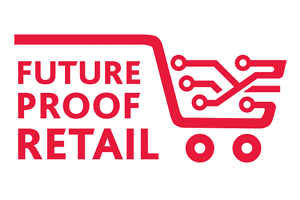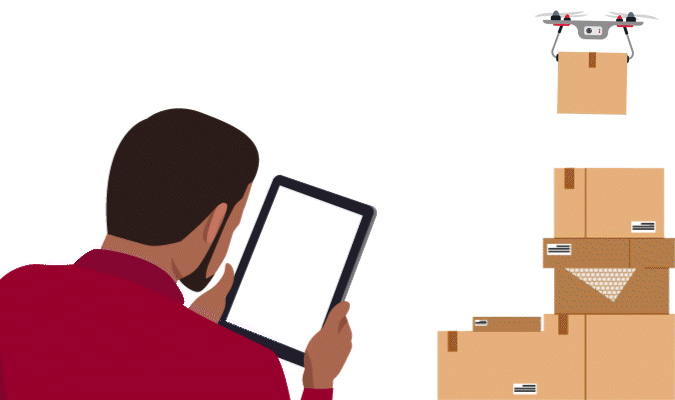Connected Supply Chains

The Supply Chain of the Future Moves at the Speed of Data
As a customer walks in and picks the last pair of headphones from the shelf, a sensor notifies an employee that it needs to be restocked. With a few quick taps on the screen of the store’s inventory control module, robots pull inventory from the stockroom and resupply the shelf. As the store associate walks away, the headphones’ digital price tag changes, increasing by $5.
It’s 2055, and the retail store of the future is almost fully online, enabling direct and connected oversight of its supply chain and dynamic pricing based on demand. Even before store employees realized that headphones would be the day’s hot-ticket item, artificial intelligence-powered analytics had noted a surge of influencers promoting the brand over the last few days. Based on the rapid uptick in online purchases, AI-driven supply chain software procured additional inventory from the manufacturer before the start of business the next day.

With more inventory on the way and the headphones’ increasing popularity, the marketing team at the retailer’s headquarters gets an alert from the supply chain system, suggesting the team add the SKU onto the website’s homepage and feature it in the holograph ads running all over Times Square. The timing couldn’t have been better either. While the headphones are flying off shelves, the waterproof wireless speakers have a major supply shortage due to a delayed cargo shipment from overseas.
The supply chain of the future takes these previously isolated events — influencer promotion, inventory on hand, manufacturer availability, advertising, and shipping — and connects them in near-real time. What once took multiple teams several days and hours of meetings to sort through is now fully automated and presented in a single, accessible dashboard for employees to act on. This results in greater agility for the retailer, better alignment of products and demand, and cost-savings that it can pass on to consumers or use to bolster the bottom line.
Keeping Shelves Full — But Not Too Full
In an ideal world, retailers would always have the exact amount of inventory to meet customer demand without any excess. Items sitting on store and warehouse shelves that aren’t generating sales force companies to either find a way to move the product through mark-downs or absorb the cost. When retailers' bottom lines are affected due to excess inventory, many will tick up prices and pass costs on to consumers, which can lead to brand erosion and loss of wallet share.
While it’s true that no one has a crystal ball to glimpse into the future, technology like predictive analytics and artificial intelligence are continuing to advance in a way that’s helping to align customer demand with manufacturing supply. In doing so, retailers are able to reduce the likelihood of stocking unnecessary inventory and better orient their supply chains toward items that are likely to generate revenue.
Getting to that point requires information and systems that can talk to one another, which is where the supply chain of tomorrow is already headed. Data that exists in a vacuum isn’t actionable in the way that holistic datasets are. When retailers understand the interplay among customer demand, inventory management, manufacturing capacity, and marketing efforts, they can take insight-driven action that wouldn’t be possible otherwise.
Smart supply chains go beyond aligning inventory between stores and warehouses. By leveraging marketing data, retailers are better able to provide their customers with advertisements and product recommendations most likely to resonate with them, which can establish personalization that fosters sales and loyalty. That information then further informs supply decisions to help companies stock what their customers want.
In the background, AI-powered tools and automation facilitate these actions, helping to alleviate the need for once-manual processes and instead allowing employees to focus on higher level, knowledge-based tasks, such as adjusting marketing campaigns around emerging trends. The speed at which this happens also helps to save time, allowing retailers to capitalize on opportunities faster.
Are you looking for ways to enhance your retail operations behind the scenes? Listen to our podcast episode, How Better Technology and Data Support Your Supply Chain, to learn how data can be applied across your network.
Connecting Present Steps to Future Productivity
Technology never stops evolving, and tomorrow’s tools may look wildly different from anything in use right now. But unlike technology, general best practices don’t become outdated so easily. For instance, the connected supply chain of tomorrow will still require sound data governance practices to be most effective. While technology advancements will ease the task of data collection, organization, transfer and storage, humans must still be in the loop. Maintaining a strong data foundation and implementing robust data governance protocols requires people to determine where and how that data can be leveraged most effectively, as well as ethically.

New tools will require adequate employee training. Even with systems coordinating with one another and acting on their own in many cases, retail employees in both customer-facing and back-end operations roles will still need to understand the critical information and metrics coming to them to make use of it. At the same time, even the most advanced tools aren’t always perfect, and employees will need to understand how to verify that the insights being presented to them is accurate and verifiable.
Pieces of the future supply chain already exist, and retailers that aren’t already taking advantage of available tools should consider how they can begin implementing them. For instance, smart warehouses are becoming more common, and many are increasingly automated. Autonomous mobile robots move product from one section to another before loading it into automated guided vehicles, with employees providing oversight and adjustments only when necessary. Throughout the factory, small camera-equipped drones provide a bird’s-eye view of the warehouse floor and feed. Rather than attempting to make wholesale changes as new technology emerges, retailers looking to future proof their business should consider what tools are available now and begin to incorporate them into standard processes.
There is an ever-growing list of ethical concerns when it comes to AI. Learn how to avoid some common pitfalls in our 60-second Retail podcast, AI Assurance Series: How Retailers Can Dodge Digital Dangers - Ethical Use.
Tomorrow’s Supply Chain Is Built on Today’s Foundation: How BDO Can Help
Transforming and optimizing supply chain operations can be a complex prospect. Future proofing the interconnected pieces isn’t like flipping a switch, and you don’t have to do everything at once. In fact, it’s often more effective to implement new policies, procedures and technologies in stages.
Key data insights that come from a smart supply chain have the potential to transform marketing, pricing, inventory management, and customer relations. In the future, more of these steps will happen automatically, but transforming supply chain processes will still largely rely on upskilled employees to oversee daily operations and make adjustments as necessary.
BDO Digital’s Data & AI services are designed to empower retailers in building a connected supply chain. By leveraging advanced analytics and AI-driven insights, we help optimize inventory management, enhance dynamic pricing strategies, and improve customer engagement through personalized marketing. Our team is here to guide you through each step of the transformation, whether it’s integrating autonomous systems for real-time inventory tracking or utilizing predictive analytics to anticipate market trends. Let us partner with you to ensure your supply chain is not only connected but is resilient, adaptive to change and future-proofed.
Ready to Prepare Your Supply Chain for a Quantum Leap?
BDO’s Retail and Consumer Products professionals understand how connected systems can benefit every facet of retail and how to leverage critical insights.